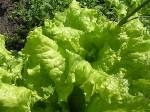All are known to the benefits of fresh leaves of various salad and spiced greenery. We eat salad, spinach, Cress Salad, Salad mustard, cucumber grass, Salad Swan, Salad Chicory Vitlug, Escariol, Endivia. In salads, not counting onion feathers, add fresh young leaves of carrots, radish, nettle and spicy plants: dill, parsley, celery, parsnik, basil, cilantro, lovers, Issop, Naughty, Mayran, Melissa, Anis, Fennel, Thyme, Water Cress, Amaranth, Mona and Rosemary.
 SALAD
SALAD
What kind of vegetable is? There is no taste, no smell, leafy, pale, sometimes puzzle ... To estimate it, you need to look into the directory, and it says that in its biochemical composition Salad occupies a special place. In its leaves, almost all known vitamins, as well as organic acids, potassium salts, calcium, iron, manganese, cobalt, copper, iodine, zinc, molybdenum, manganese, boron, carotene, vitamins C, E, B2, K, RR, Folic acid, and the content of calcium salts salad occupies first place among vegetables.
Different varieties are distinguished by the form and color of the leaves. They are light green, yellow-green, bright green and dark purple-red. In some varieties, they form a magnificent rosette near the surface of the soil, others are in kochan chiki. Salad seeds usually have a high germination and quickly germinate. This is one of the earliest crops.
For open soil, the following varieties are large, Riga, Clavier, Berlin Yellow, Sofi, Festival.
For closed soil: contribution, Kamaryansky, May, Desiso, islantha, Naraz, New Year's Eve.
Salad is a cold-resistant plant. Its seeds can germinate at a temperature of 5-7 ° and give friendly shoots in 5-7 days. Young plants carry temporary freezes from -1 to 6 °.
In the open soil, salad seeds are seeded early in the spring as soon as the soil matures. Sow it in an ordinary way across the groin. The distance between the rows is 18-20 cm, between the seeds of 1.5-2.0 cm. To speed up the ripening, crops are covered with a film stretched on the arc. Under the film, a Beijing cabbage can be grown with a salad (their agricultural engineering coincides). To have fresh products for a long time, crops repeat the Chepes of 10-12 days in April and May. Shoots thin 1-2 1 times, leaving between plants a distance of 5-7 cm for sheet and 20-25 cm for knocked salad.
By time consumption, all varieties are divided into spring, summer and autumn.
For rapid growth of high-quality leaves, a light warm place is required (better on the southern slope), high humidity of soil and air, fertile loose soil. At 1 m2, 3-4 kg of dung hill and full mineral fertilizer should be added to the salad and the total mineral fertilizer (according to the instructions).
Salad loves neutral soil, so 250-300 g of lime should be made by 1 m2. With the onset of hot dry weather, it is necessary to loosen the soil more often, and the plants daily water. From high temperature and dry soil salad ceases to grow, its leaves become dry and sluggish, bitterness accumulates in them.
Salad cleaning is carried out 30-40 days after its shoots appear.
New Zealand Spinach
 This is one of the species of spinach, which is growing in a wild form in New Zealand and Australia. In Europe, it is grown from the XVIII century, but in our country he gained popularity recently, and grown it mainly in garden and household sections.
This is one of the species of spinach, which is growing in a wild form in New Zealand and Australia. In Europe, it is grown from the XVIII century, but in our country he gained popularity recently, and grown it mainly in garden and household sections.
In its chemical composition, this type of spinach is not much different from others. It contains protein, sugar, carotene, vitamin C, organic acids (oxal and nicotin). Its young shoots and fleshy leaves are used in food in fresh and processed, in children's and diet nutrition.
In addition to anti-cutting properties, this spinach has a number of healing qualities: it is favorable on the pancreas and in the stomach, as it contains a special substance - secretine. Unlike the usual cold-resistant spinach, New Zealand is a very thermal-loving plant. It slowly grows at the beginning, requires a rich soil and increased moisture in it.
In the southern regions of the country, the New Zealand Spinach grown in the open ground, he even gives self-sowing, in the non-black earth it is grown by a seaside, but at the same time the seeds do not have time to grow.
The New Zealand spinach has rounded smoothly branching stems, sharpening on the ground, and spirally located on the stems of the leaves. Flowers are sitting in the sinuses of the leaves, and the seeds in the hard shell are in the fruits (dry multiferous nuts, 3-8 pieces each).
Growing seedlings
New Zealand spinach seedlings are grown in containers, drawers or individual pots. Seed seed at the end of March - early April. Previously, they are soaked for a day and germinated in a wet tissue at a temperature of 22-27 °. Seeds germinate unevenly, therefore only sprouted.
In the individual pots of up to 10 cm in diameter, 2-3 seeds are sown.
When sowing in boxes, shoots are picked in the phase of one or two leaves.
In the open soil, seedlings are planted at the age of 40-50 days at the end of May - early June. The distance between the individual plants is 40-50 cm, between the rows of 80-100 cm. In each desirable to pour 300-400 g of humus or compost and 25-30 g of full mineral fertilizer with trace elements. Cleaning starts 3-4 weeks after disembarking: oline-twice a week is cut off the tops of 15-20 cm leaves and separate leaves.
Caring for the New Zealand spinach, follows more often to loosen and water the plants. In hot and dry weather, spinach quickly grisges and reduces quality.













 Start a discussion ...
Start a discussion ...